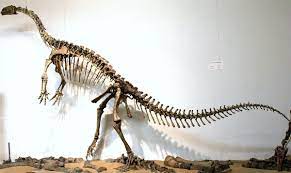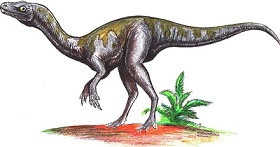
Nyasasaurus is an early Dinosaur genus that was first described in 2012. It is one of the oldest dinosaur species discovered and is believed to have lived during the Middle Triassic period, approximately 245 million years ago.
Nyasasaurus officially named Nyasasaurus parringtoni, was first described in 2012 by Sterling J. Nesbitt, Paul C. Sereno, and others. The fossils of this ancient dinosaur were found in the Ruhuhu Basin of Tanzania, Africa. The genus name Nyasasaurus refers to Lake Nyasa (now known as Lake Malawi), near the discovery site, while the species name parringtoni honors Dr. C. Parrington, an influential British paleontologist.
| Name: | Nyasasaurus dinosaurs |
| Size: | around 2 to 3 meters. |
| Main Facts: | Nyasasaurus is one of the oldest dinosaur species, offering crucial insights into early dinosaur evolution and the dawn of dinosaurs. |
Nyasasaurus is classified as a basal dinosaur, which places it at the base of the dinosaur family tree. As such, it is crucial in understanding the early stages of dinosaur diversification and evolution. Its discovery has helped resolve long-standing debates about when dinosaurs first appeared on the scene.
The Middle Triassic period was a critical time in Earth's history, following the Permian-Triassic extinction event, one of the most significant mass extinctions in the planet's history. During this time, the ecosystems were recovering and witnessing the emergence of new life forms, including early dinosaurs like Nyasasaurus.

The discovery of Nyasasaurus has played a crucial role in illuminating the dawn of dinosaurs, providing evidence that dinosaurs emerged much earlier in geological time than previously thought. Prior to the discovery of Nyasasaurus, the oldest known dinosaur species dated back to the Late Triassic period, around 230 million years ago. Nyasasaurus pushed this timeline back by about 15 million years, extending our understanding of the early stages of dinosaur evolution.
During the Middle Triassic period, the region that is now Tanzania was part of a larger landmass called Pangaea. The climate was generally warm, and the landscape was dominated by lush forests, vast floodplains, and a diverse array of fauna. Nyasasaurus coexisted with a variety of other prehistoric creatures, including early crocodile relatives and other archosaurs.
Nyasasaurus a dinosaur from the Middle Triassic period, is one of the oldest dinosaur species discovered. Found in Tanzania, it is a small bipedal dinosaur, around 2 to 3 meters in length. As a basal dinosaur, it holds key insights into the early stages of dinosaur evolution, rewriting our understanding of when dinosaurs first appeared on Earth.
Nyasasaurus has significant implications for the study of Mesozoic ecosystems and the role of dinosaurs in shaping life's diversity during that time. Its discovery has sparked a new chapter in paleontological research, unraveling the mysteries of the "dawn" of dinosaurs.
Nyasasaurus is one of the oldest dinosaurs, dating back to the Middle Triassic period, approximately 245 million years ago. Most other well-known dinosaur species appeared later in the Mesozoic Era, during the Jurassic and Cretaceous periods.
Nyasasaurus is estimated to have been a small dinosaur, around 2 to 3 meters in length. This makes it much smaller than many other dinosaurs, including the massive Sauropods and some large Theropods like Tyrannosaurus rex.
Nyasasaurus is considered a basal dinosaur, located at the base of the dinosaur family tree. In contrast, other dinosaurs represent more derived and specialized groups within the dinosaur lineage.
Nyasasaurus lived during the Middle Triassic when the Earth's ecosystems were recovering from the Permian-Triassic extinction event. Other dinosaurs lived in different geological periods, experiencing different environmental conditions and ecological interactions.
Like many other dinosaurs, Nyasasaurus was a bipedal dinosaur, walking on two legs. This characteristic is shared with many later theropod dinosaurs and some ornithischian dinosaurs.
Nyasasaurus' dental remains indicate it had serrated teeth, suggesting it may have been carnivorous or omnivorous. This feature is similar to that of some early theropod dinosaurs.
While direct evidence of feathers in Nyasasaurus is lacking, many other theropod dinosaurs, especially those in the Coelurosaur clade, are known to have had feathers.